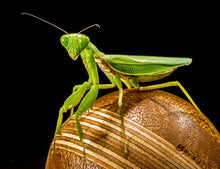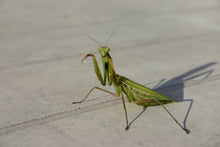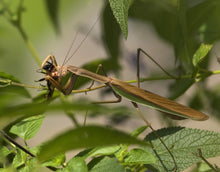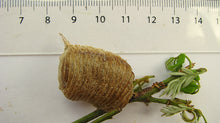
Buy one, Get one FREE! Add 2 cases to your cart to get the free egg case.
Praying mantis are beautiful insects with a voracious appetite, and a delight to have in the garden. Being strictly carnivorous, they'll eat almost any insect of a size they can overcome. Waiting in quiet ambush for hours at a time, when an insect comes wandering by they suddenly jump out and attack - always biting the neck first. At rest, they seem to be "praying", holding their "hands" together.
Each praying mantis egg case will hatch about 100-200 tiny mantises, all at once. In order to hatch they'll need several weeks of warm weather, so they can "sense" that summer (and pest insects for food) has arrived.
Once hatched, praying mantis begin feeding on small insects, such as aphids, spider mites, lacewings, and any other insect smaller than them. Later on, they'll continue advancing up to larger and larger prey. By summer's end, praying mantis can reach several inches in length. In the fall, females produce more eggs, deposited in a frothy secretion that hardens to protect the eggs from predators and severe winter climates. Egg cases are attached to twigs, leaves, fences, etc. Several egg cases may be laid before cold winter finally sets in. This new generation of praying mantis will hatch when warm weather returns, to repeat the process.
Attach the egg cases in their mesh bag to a twig or plant about a foot or two off the ground where there's cover to protect the babies.
When hatching, the young crawl from between tiny flaps in the cases and hang from silken threads about 2" below the case. After drying out, the long-legged young disperse into the vegetation, leaving no evidence of their appearance. This happens within an hour or two, and it's very difficult to know hatching has occurred unless the elusive, well camouflaged young are found. (The egg case does not change appearance in any way.)
If you'd like to see when the mantis have hatched, place the egg cases in a paper bag, fold the top and seal shut with a paper clip or clothes pin. Place the bag on a window sill in direct sunlight. Periodically open the bag carefully, and when you see tiny mantids running around inside, take them outside and sprinkle them throughout the garden. Be patient - sometimes it takes up to eight weeks of warm weather for them to hatch.
When hatching, the young crawl from between tiny flaps in the cases and hang from silken threads about 2" below the case. After drying out, the long-legged young disperse into the vegetation, leaving no evidence of their appearance. This happens within an hour or two, and it's very difficult to know hatching has occurred unless the elusive, well camouflaged young are found. (The egg case does not change appearance in any way.)
If you'd like to see when the mantis have hatched, place the egg cases in a paper bag, fold the top and seal shut with a paper clip or clothes pin. Place the bag on a window sill in direct sunlight. Periodically open the bag carefully, and when you see tiny mantids running around inside, take them outside and sprinkle them throughout the garden. Be patient - sometimes it takes up to eight weeks of warm weather for them to hatch.
Sorry, we do not ship outside the U.S. or to Hawaii due to agricultural restrictions.
We guarantee the safe arrival of all of our products. During the warm summer months until September, praying mantis are out of season.
Customer Reviews
Based on 3 reviews
Write a review







